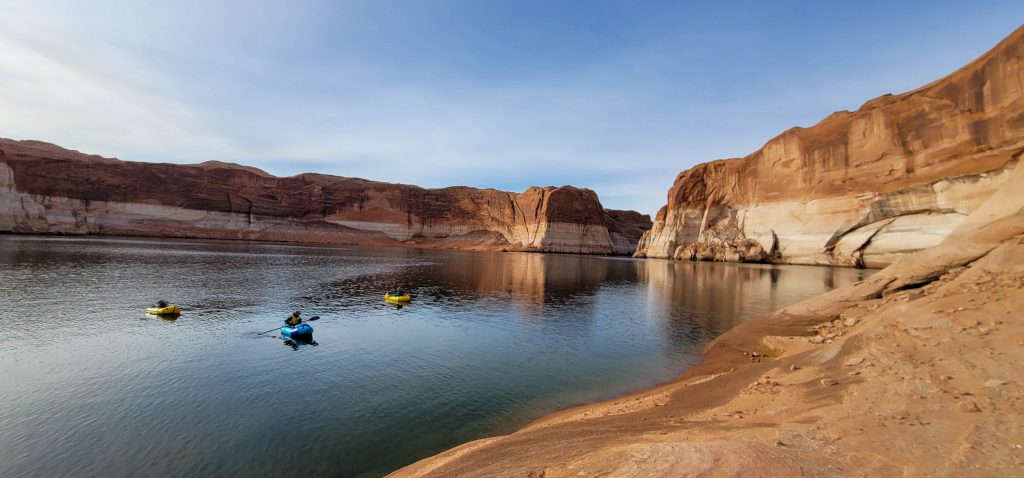There is no way for me to know for sure, but it sure looked like an escape route to me.
The desert varnish had 4 or 5 steps carved into its near-vertical wall. This gave access to a strip of sandstone that hung to the canyon wall. At 3 or 4 feet at its widest, it was plenty big enough to maneuver but my hands got sweaty even thinking about it due to the exposure. This strip lead up and over a knob that continued over the top of the alcove we were camping in. And at the far end of said ramp was access to the endless sea of sandstone above us.
When I first noticed the steps, I kind of just stood there enthralled with the idea of why, where, who and what was up above. Said escape route hung next to a giant panel of very old petroglyphs that sit under an arch that is only an arch by definition. It has the shape but is only separated from the wall behind by several inches at the top giving it a unique feel.
This arch sits next to a giant alcove that has a distinctive floor. It’s almost tile-like in look and feel and by my best guess formed when a flood from the stream below came up high enough to deposit a thick layer of clay that then dried and got cooked in the alcove turning it into a hard, smooth surface. Seeing that it sits in an alcove, it hasn’t seen moisture since and is the closest thing to a tile floor I’ve ever seen naturally created. The Alcove sits in a perfect spot. Water happens to trickle up at its base and the canyon is open enough that there is plenty of room to move around. There is flat space on both side of the creek and another alcove sits parallel. The creek that bubbles up drains into what quickly becomes a narrow slot canyon leading to the Escalante River. There are plenty of hints suggesting people occupied this space continuously for quite some time.
The location of this arch and alcove suggests to my subpar modern brain that this was an ideal location to inhabit. There was water, protection from the elements, space to grow crops and move around. And in the case of an attack, a nice ramp that lead up and out of the canyon for a quick escape that could be easily protected from above.
An escape route.

Shelby says it again, “You can tell we are getting close because of the smell of death.”
I chuckle in response because it’s true.
What is often seen as a life-giving presence in this environment is also keenly a dead place. And with that comes a unique smell. One of stagnant water, rotting vegetation and filth that permeates up the canyon as the afternoon breeze blows up and off of the reservoir. It’s not uncommon, in our experience, to find animal carcasses at the boundary of reservoir and stream. We’ve seen dogs and beavers among other things. This year it’s a mountain lion. One thing is consistent. The smell of death.
Knowing the smell, knowing that we are getting close, we all start to think about the transition. If you’ve never been to this boundary area of post-dominy apocalypse that rips at the sense and threatens your forward motion, you might think it’s easy. You might think there is a nice sandy beach that you can stroll up to, roll out your pack, eat some lunch and then you push off and start paddling. While that is a possibility, it has never coincided with our reality.
As dead cottonwoods begin to emerge from the sand and the banks of sediment get higher and higher, our pace always slows. We begin to pick our footing carefully and watch for that line where flatwater begins and flowing stream ends. As we near that spot, we know there is a high chance of quicksand and/or death mud. A place where one misstep can leave you knee-deep in slop that does everything possible to keep you from escaping. Especially with the heavy loads we are carrying.
Strapped to our backs are small little boats that don’t track well, handle flat water or wind that great but are small and light enough to pack. These are the key. Without them, this whole route would be considerably harder, if not impossible. At the point of transition, they are both an obstacle and a way. On the one hand, they weigh us down, slowing our pace and pushing us deeper into the muck that impedes our progress.
And on the other hand, they are our escape from the canyon, from the transition zone and onto the flat reservoir at the bottom of the canyon.

For years, the desert was my escape route.
My brain, like most people’s these days, is a bit of a mess. Thanks to the random genetic anomalies that form who I am in conjunction with growing up in the fastest-paced era in human history, I have suffered through panic attacks, severe depression and the complete loneliness that often accompanies those things when one does not possess the language to discuss what is happening. The desert was my therapy. It was the place I could go to to have everything fade into the background, where my brain could stop, where I could escape my own existence without ending it.
I would be sure to have a plan. Some time set aside to walk out into the open land, reconnect with the nothingness that should inhabit my brain and shut off the incessant noise that bombards us. While in the desert, everything would fade into a stillness. This stillness was my happy place and I used it as such disappearing, forgetting. Always happy to go there, always happy to be there.
The problem with escaping is you become a fugitive, on the run, attempting to outpace whatever it is that you are running from. Most times, that thing isn’t something you can elude. The idea of an escape suggests that if you are successful, you will be free. In reality, it also suggests that you may be free, but you’ve also lost the ability to choose to stay.

We’ve been here before.
It’s not often we return to the same place in the desert. Sure, there are those quick trips that are just easy, high reward for low input that kind of just happen any time we have an unplanned weekend. But returning to a place that is difficult to get to doesn’t occur. Once you’ve experienced it, there is always a desire for a repeat, but there are too many other hard-to-get-to places that need your attention, so you go there instead.
This was an exception.
Yes, we had been here before a few years ago. It was a great trip. One that held mysteries we didn’t have time to explore. It was even talked about regularly, but it always got pushed back because, well, we had already been there.
The timeline of this place exists in three epochs. There is a giant chunk of time that was Pre-Dominy. A river ran through it, the canyons existed the way they had evolved and there were endless treasures abounding in nooks and crannies that some had seen, but few even knew existed. Then there was the Flood. Everything below a certain elevation, in every direction, was slowly filled up by water. This left the tops of canyons peaking out of a reservoir. Landmarks changed. Things that were admired were no longer and the world that had existed was buried. It was a backup plan, a way out, an escape route so the west didn’t have to deal with its water issues.
As the sandy foundation of that escape route erodes, we have entered the Post-Dominy era. A time when we can’t pretend that water will just keep filling this reservoir despite the petitions demanding the contrary. As the flood begins to recede, those nooks and crannies and canyons and landmarks and waterfalls and arches and alcoves and … have begun to rise, to escape from the water that kept them hidden and secret for so many years.
We round the corner of the canyon to see the arch rising from the water. When we were here a few years ago, we paddle 75 feet or so over the top of this arch without any visible indication that it even existed. To say this place has changed is an understatement. Not only has the route we are able to paddle been drastically altered, but the esthetic, the sounds, the winds, the water, it’s all emerging, changing, escaping from the flood.
The deep green water reflects our colorful boats and the arch we’ve never seen. Yes, we’ve been here before, but we’ve also never been here before.

It’s a strange feeling for me.
I push my thumb onto the fingerprint reader and listen as the deadbolt snaps open. There is a smile on my face and I recognize that what I’m feeling is new. The door swings open and the three puppy faces are beyond excited to see me as they wait impatiently behind the child gate keeping them in the back of the house. I hobble in and drop my pack before moving in for puppy love.
I used to get anxious as a trip would near its end. The thought of returning to the norm, the fast-paced, non-stop life we lead, would push my brain into overdrive even though everything around me was quiet and calm. I could look forward to the comforts being home provided, but I always dreaded my return. This also coincided with the premonition that PEAD (Post Epic Adventure Depression) would be nipping at my back feet as soon as I landed. To be excited to be home, this was new for me and it felt significant.
Utah Philips once said that the problem with running from your troubles is that you have to stop at some point and wherever that point is, all the troubles you’ve been running from will hit you in the butt. Using the desert as my escape route proved his point. I could escape, but the moment I returned, everything I had escaped was still here waiting.
There is, as Krakauer chronicles in Eiger Dreams, often a value we pre-assign to trips. We have this idea that by going and doing something, we can change our situation. We go and do the thing, leaving behind our lives, our people. Even while we are doing the thing, we feel a deep change. A sensation that this is it, this is what we’ve been waiting for, wanting. There is a huge sense of accomplishment, the euphoria of success.
And then you return home.
No one cares about where you’ve been or what you’ve done. The life and people you left behind continued on their trajectory and you just plopped back into what you were running from. Soon the adventure fades, the euphoria of success dwindles and you are back in it. And almost immediately you begin the process of finding that next thing that will take you back to the summit. It can turn into a vicious cycle.
Our lives are made up of small things, our habits, that control and predict what our lives are going to be. If you could take the day to day of backcountry travel and perpetuate it, then it would be life-changing. For most of us, that just isn’t a realistic option.
Over the winter break, our plans for escape were altered due to the weather. It was raining everywhere that we wanted to go to escape and instead decided that we would embrace the cold. We ended up in Bryce Canyon. This left us sleeping in a hotel bed and within cell service for the majority of our break. I quickly realized this wasn’t going to equal my time in the desert. The calm wasn’t there, even as I sat watching the snow falling and reading next to the window. I realized the biggest difference was that my phone kept interrupting. I wasn’t needed anywhere, but the nudges to worry, to help out back at home never stopped.
And then I put my phone in airplane mode.
Within a couple of hours, I felt like I was on vacation. The nagging was gone and I could settle into relaxing like I usually did as soon as we leave cell service. Of course, once I turned it back on and the bells started ringing, it was back. This got my old thinking muscle running. After a day or two of being home and having the notifications back on, I just went ahead and turned them off one night. It felt liberating. I figured I would try being notification free for a few days. If I still felt great, the shop hadn’t burned down and people weren’t running away from me because I didn’t respond in two seconds, I would leave them off. Not surprisingly, none of those things happened. Everything still got done, but I found myself enjoying being at home.
I’ve continued this experiment and even expanded it over the past few months. My phone now only notifies me of phone calls and text messages and I rarely look at it. When I was at work, I realized I was constantly being distracted and, while the notifications were meant to help me get things done, they did the opposite. I couldn’t focus. So I turned them off on my computer as well. The surprising piece, nothing has really changed outside of me being able to focus and get things done. I still communicate quickly enough that no one has noticed that I’m not being constantly notified. And more importantly, I’ve been able to get more done as I’m not constantly distracted from the task at hand.
You could say I’ve escaped my notifications. This route has allowed me to perpetuate a small piece of what the desert has always provided, stillness, quiet, slowing down. Now I walk in the door and there isn’t a flood of impending annoyance. I can walk in and think just about my puppies and be happy to sit on the floor and revel in their attention.

This place had been submerged or partially submerged for 50 years.
It was chilly when we walked down the beach and got into our boats. The water is cold and the sun has provided almost no relief. With cold feet, we stepped onto a beach that consisted of quicksand and death mud coating our already cold feet with more chilling substances. The alcove had not seen any sun yet and probably wouldn’t for a while. We walked through the trickling stream, over the wet sand and peaked into the place. Even though we came prepared for something awesome, we were all struck by the beauty before us.
Despite completely frozen toes, we lingered. It’s called a Cathedral and I felt very much like it was. There was an inherent reverence required to be there. To appreciate that we were some of the first to experience this place as it was, was almost spiritual. It was escaping the reservoir. We were escaping day-to-day life, and as strange as it might sound, I felt like I was home.
Eventually, the cold overtook us and we were forced to retreat, escaping the shade and dampness that the Cathedral held. Once we had found the sun, we sat quietly admiring the entrance and trying to process what we had experienced. We most likely would have stayed perched in that sun all day, but this particular escape was short and we had miles to paddle to find our own way out of this reservoir, preferably the one that would lead us back to our cars.

If escaping makes us fugitives, the only way to escape being a fugitive is to make a stand.
It’s important to have an escape route. Much like those Moqui steps leading up the side of a vertical sandstone wall, we need a way out. When our world becomes too much, we need a place we can go to regroup and sort out how to move forward. Sometimes that means running. It can mean flooding a beautiful canyon to attempt to ensure a desert has water and then it can be those waters receding and those flooded places emerging again.
And other times, the escape route can be as simple as sitting down and being still. It can be simply taking a stand and sorting out all the bull shit that comes rushing up and bumping into your butt. The hard part is to know when to run and when to sit.
Embrace Chaos. Seek Discomfort.


